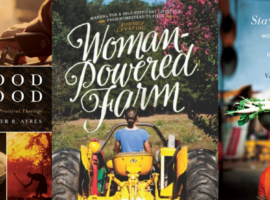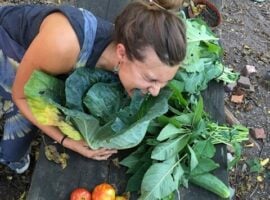For Women’s History Month, we recognize the great strides and invaluable work of women worldwide contributing to the transformation of our human landscape through social, economic and, of course, food justice.
Patti Naylor farms with her husband George in west-central Iowa, growing non-GMO and organic corn and soybeans, oats, hay, cider apples, and chickens. Patti speaks and writes about agriculture, farm justice, and the principles of food sovereignty, recently participating in events with Food First on capitalism in the food system, at the UN CWS62 in NYC with the Women’s International League for Peace and Freedom (WILPF) on industrial agriculture’s negative impact on rural women and in Washington, DC, with ActionAid on biofuels. Patti has visited La Via Campesina farmer organizations in Cuba and Nicaragua to further her understanding about food sovereignty and agroecology. Recently, she has focused on how organic and agroecological principles can mitigate climate change. She is a board member of Wisconsin-based Family Farm Defenders, a member organization of National Family Farm Coalition and US Food Sovereignty Alliance.
Patti took out time to share her journey and insights with WhyHunger in our latest interview with the Iowa-based farmer.
What is your experience like being a woman in the farming industry? How does it impact your farming practices, if it does?
My farm is in Iowa, with black, fertile soil and where corn and soybeans dominate the landscape. To be a woman farmer here is not impossible, but there are unique challenges. I cannot do the physical labor that my husband and other men are able to do. That is a fact, but it also means that I am a partner with my own skills and abilities. I am fortunate that my husband appreciates the work that I do. While I do drive a tractor during spring and fall field work, my primary roles are keeping the records for our organic certification, tending our large home garden and our chickens, and both planning and helping with the work in the orchard. My husband and I also make many farming decisions together. My involvement in the farm was very important in our decision to transition to organic production.
In thinking about women’s history month, are there any role models or women in food/farming that have inspired you?
My mother is my inspiration. I don’t believe she would have self-identified as a farmer, but it was how she exhibited such a love for life on the farm that I think about today. She loved to work outside, especially in her garden. Most of her work involved feeding her family. Besides all the fruits and vegetables that she canned and froze for future meals, she also butchered her own chickens, a mighty task. I gain strength and courage from my memories of her speaking out against a factory farm [Confined Animal Feeding Operation (CAFO)] that was proposed near our family farm. She won the battle, but was ostracized by friends and neighbors for her actions. Any time I speak out for family farmers today, I do it with Mom on my mind.
How has agroecology supported your farming practices?
In the past five years, my husband and I have made great strides in transforming our farm from strictly corn and soybean production (even though it has always been non-GMO) to organic production. We have tried to include Agroecological principles on our farm and are investigating more ways as the farm evolves. We planted an orchard with flowering culinary and medicinal herbs within and around the orchard, and use holistic sprays to nourish the trees and deter pests. We added pollinator and prairie habitat that complement the wetland, and incorporated small grains and hay into our crop rotation. Our chickens provide meat for our dinner table, manure and bedding for my garden compost pile, and insect control as they roam under the apple trees. We hope to bring in more livestock to the farm soon.
What have you found to be some of the greatest challenges as a farmer? Greatest triumphs?
Transitioning the farm to organic production that also recognizes the ecological connections of our farming practices to the environment has been a beautiful and even spiritual change in my relationship to the land as well as to the wider community around me and around the world. I am a farmer. That reality connects me with farmers and peasants around the world – and to the challenges that we all face as we work to produce food in the existing capitalist, corporate, industrial system of agriculture that dominates food production here in the United States and increasingly around the world. Neoliberal policies that tell us that only global markets through free trade agreements will both feed the world and make farming profitable are, in fact, destroying the diversity of people, crops, livestock, and ecosystems.
The multiple and existential crises that people and the planet are facing today – climate change, insect population collapse, species extinction, deforestation, chemical pollution, access to clean water, farmer suicide, hunger and poverty – can be linked to our agriculture, trade, and foreign policies. The military-industrial complex and disaster capitalism benefits from disruption, insecurity, instability, and uncertainty.
The challenge is overcoming that feed-the-world narrative in which technology will make this extractive system sustainable. Farmers such as my husband and I must work within this system to sell our crops. We must compete with the global market for organic corn and soybeans, and adding perennials and small grains to our crop rotation adds financial risks. Farmers around us who use genetically modified seeds and harmful pesticides on corn and soybean crops have very few options even as they see their high yields contributing to the global supply of grain and lower prices for their products. Low prices for these feed crops allows livestock in confinements to be profitable, which in turn takes the livestock off the farm, makes crop rotations of perennials unnecessary, and destroys the diversity of income for farmers as well as biodiversity. This is a farm crisis as we lose more farmers, being replaced by managers and employees who do not have the close connection to the land and their communities.
I am encouraged by the peasant organization, La Via Campesina, which works to bring attention to these issues and brings together farmers and peasants around the world to create positive change. The organizations of the US Food Sovereignty Alliance, including National Family Farm Coalition, work on state and federal policy, support farmers in both rural and urban settings, and connect consumers to their food. Truly, we must learn to care for Mother Earth, re-connect to the land and to our food, and recognize the impact that food and farming – and the ways in which we live – have on the future of all that we know.
What would food sovereignty in the U.S. look like to you?
Food sovereignty is grounded in respect for the resources we have within our own communities to produce food – the land, water, pollinators, and more – and for the people who produce that food. With respect, we also understand the value of having a food system that works with the ecology of the region, produces healthy food for local and regional consumption, involves fair (not free) trade of agriculture products to enhance the diet of citizens and the economic stability of producers, and includes government policies that stabilize the food supply.
Food sovereignty is achievable, but to get there, we must all join together through democratic processes to build a mutually supporting system of producing food within Earth’s ecological boundaries. We will no longer choose our foods based on the most appealing marketing displays or its convenience of consuming, but instead based on the local or regional season, the farmer or the cooperative from which it comes, and the integrity of the ecologically-sound farming methods by which it was produced. People will be valued for their work with fair prices for farmers and fair wages for workers, allowing for dignity of people and protection of resources. The environmental costs will be internalized into the cost of the food.






